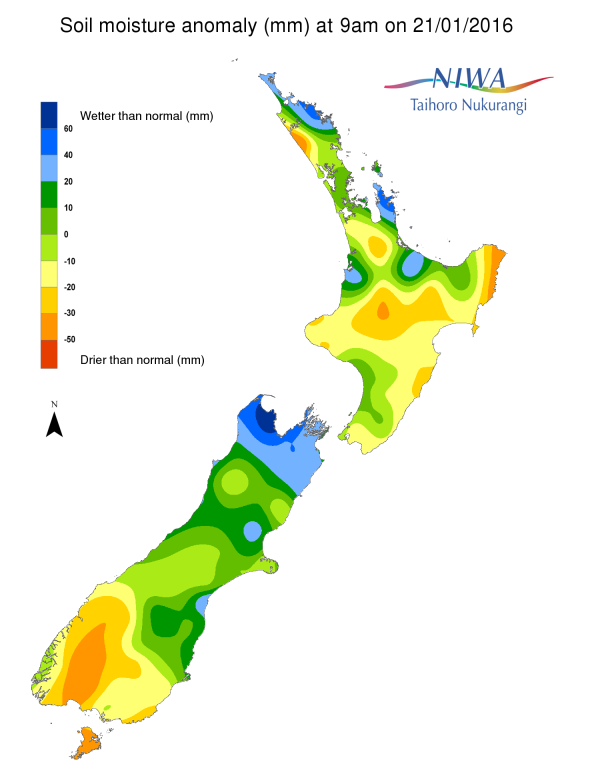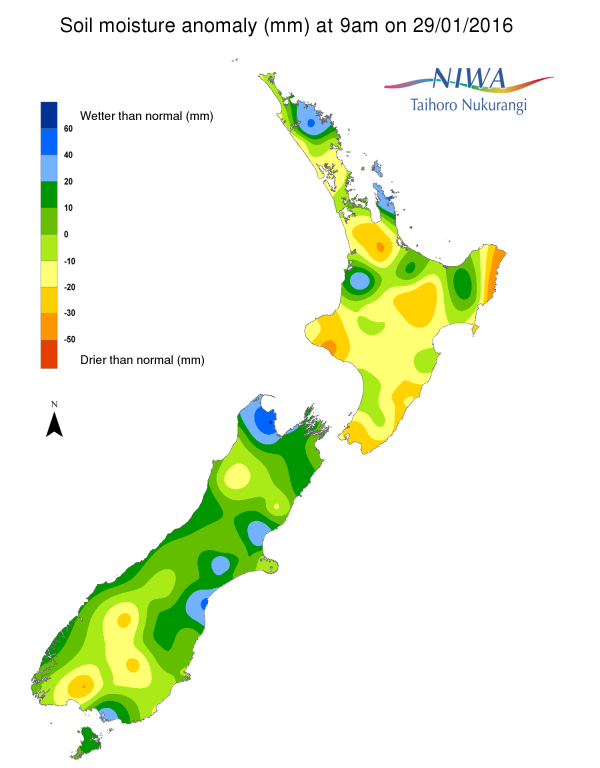A weekly update describing soil moisture across the country to help assess whether severely to extremely dry conditions are occurring or imminent. Regions experiencing these soil moisture deficits are deemed “hotspots”. Persistent hotspot regions have the potential to develop into drought.
Soil Moisture
Over the past week, soil moisture levels across the North Island have mostly remained the same or decreased. The exception is from northern Manawatu-Whanganui into southern Waikato and interior Gisborne and Hawke’s Bay where soil moisture levels have increased slightly. At this time, central Waikato, much of Taranaki, interior Bay of Plenty, eastern coastal Manawatu-Whanganui and Wellington have below normal soil moisture for this time of the year. Soil moisture is near to above normal in Northland, southwest Waikato, coastal Bay of Plenty and interior Gisborne.
Across the South Island, soil moisture levels have generally remained the same or increased. Exceptions include Tasman, Nelson and Marlborough where soil moisture levels have decreased slightly. The most substantial increases were found across much of Southland and southern Otago. Soil moisture levels are above normal for this time of the year near the southern border of Southland and Otago, across mid-Canterbury and in northern Tasman but below normal across interior Southland and Otago.
Outlook
Rainfall
For the North Island, scattered rains are expected this weekend, especially in central and northern areas. Totals will be most significant across northern Hawke’s Bay, Gisborne and the Bay of Plenty where falls of 10-25mm are expected through Sunday with local amounts in excess of 25mm. Similar amounts are expected across Northland, heaviest on Sunday when isolated thunderstorms may bring up to 50mm in a short period of time. Auckland to western Waikato is also at risk for a locally drenching shower or thunderstorm on Sunday, totalling up to about 25mm in a few places. The rest of the North Island will have rainfall generally totalling less than 10 mm this weekend, except less than 5mm in southern Manawatu-Whanganui and Wellington. A drier weather pattern is expected to establish itself early next week on the North Island with high pressure in control. Aside from the odd sprinkle, Monday and Tuesday are expected to be mostly rain-free. In the mid- and late- week, a storm over the Tasman will spread moisture toward the region. Right now, it looks like late-week rainfall will focus over the northern portion of the island with falls in the order of 5-10 mm. There is a slight to moderate chance that places in the eastern portion of the North Island, from Gisborne to Wellington, are largely dry for the duration of the work week.
The central and northern South Island will have some rain on Saturday. Patchy light rain and drizzle form Canterbury to Marlborough, Nelson and Tasman will give 5-10 mm. Dry weather will return to the aforementioned regions on Sunday. Elsewhere on the South Island, dry weather is expected both days of the weekend. Monday, Tuesday and Wednesday are expected to be generally dry across the extent of the South Island with high pressure in control. Some late-week rain is possible with the south and west of the Island most likely to see appreciable falls. Meanwhile, areas from eastern Otago to Canterbury may remain dry for much of next week.
Soil moisture
For the North Island, hotspot areas are present in central Waikato, extreme eastern Gisborne, south coastal Hawke’s Bay and interior Taranaki. Hotspots across much of the island will need to be monitored for expansion over the next week. Scattered rains this weekend may briefly reduce hotspot coverage, especially in the north; however, a dry period into the middle stages of next week may favour hotspot expansion, especially in the southern and eastern portion of the island.
Hotspot areas, though reduced compared to last week, are still present in interior Southland and interior Otago on the South Island. Little rainfall over the next 3 to 5 days may promote hotspot expansion in these regions, though rain late next week may lead to another reduction in coverage. Dryness around Christchurch over the next week may lead to hotspot development. Additional hotspot development is not anticipated this week.
Background
Soil moisture deficit
Soil moisture deficit is the amount of water needed to bring the soil moisture content back to field capacity, which is the maximum amount of water the soil can hold.
Soil moisture anomaly
Soil moisture anomaly the difference between the historical normal soil moisture deficit (or surplus) for a given time of year and actual soil moisture deficits.
Definitions
“Extremely” and “severely” dry soils are based on a combination of the current soil moisture status and the difference from normal soil moisture (see soil moisture maps at https://www.niwa.co.nz/climate/nz-drought-monitor/droughtindicatormaps)
Soil moisture anomaly maps
Pictured below are soil Moisture Anomaly Maps, relative to this time of year. The maps show soil moisture anomaly for the past two weeks.


